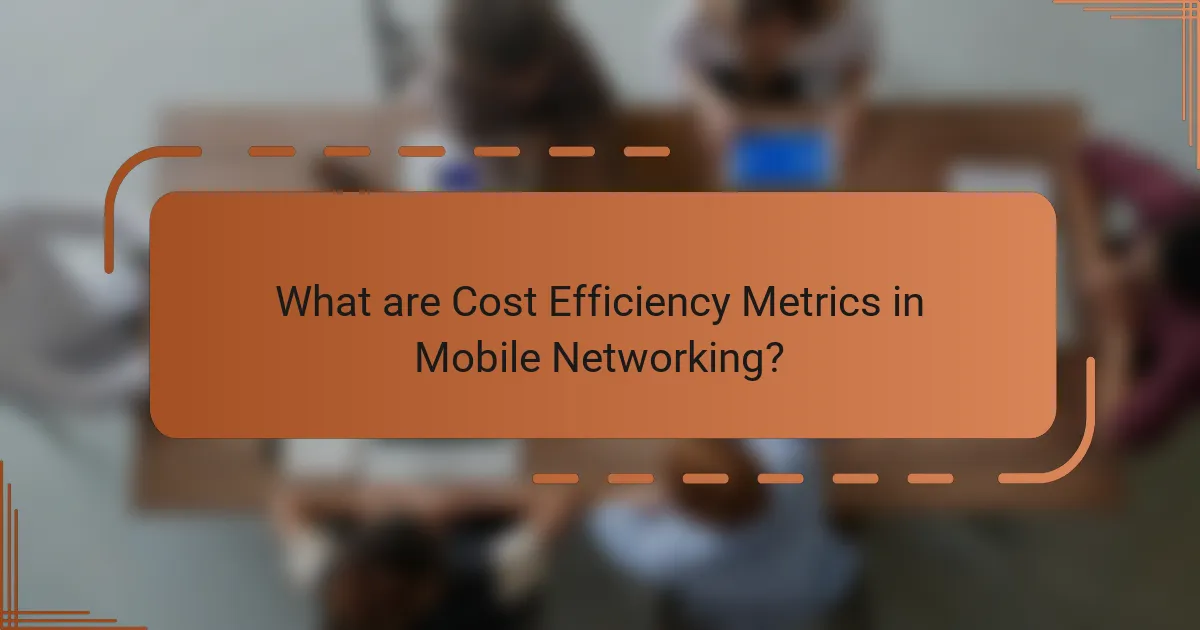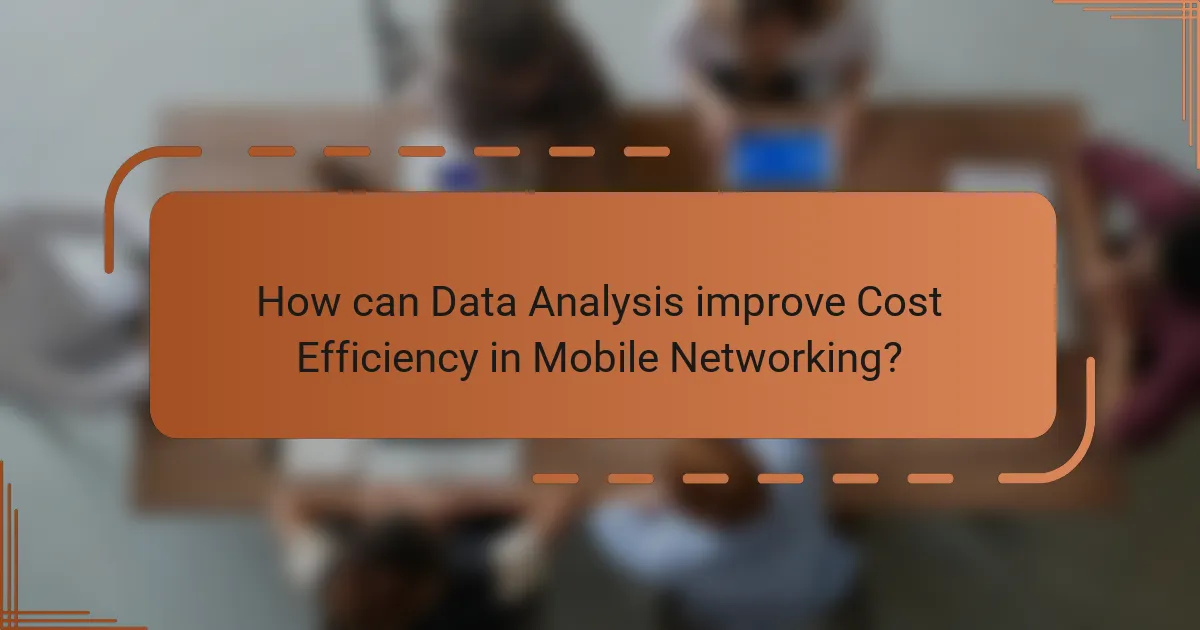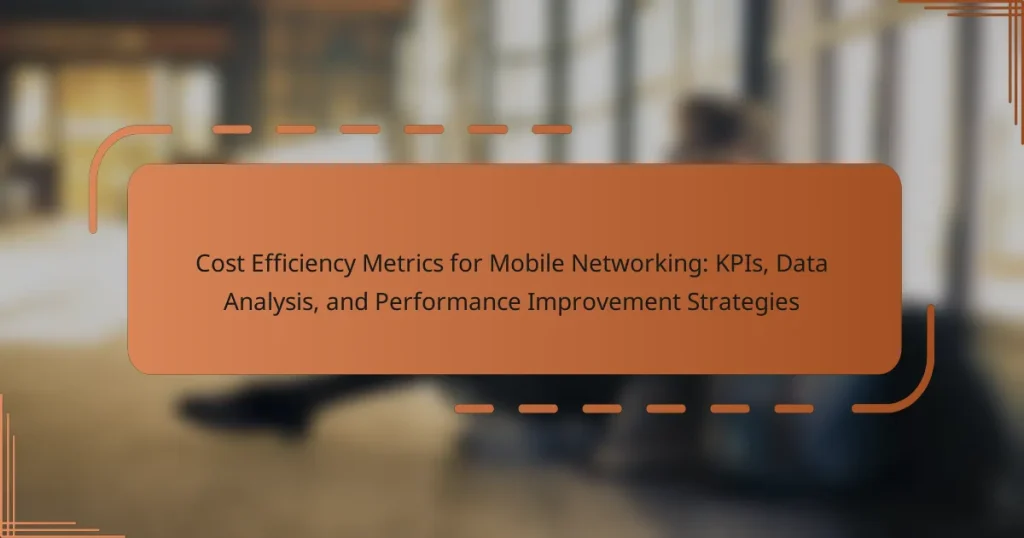Cost efficiency metrics in mobile networking are quantitative measures that evaluate the economic performance of mobile networks, focusing on the relationship between costs and network performance. Key metrics include cost per user, cost per gigabyte, and return on investment (ROI), which help operators identify areas for improvement and optimize resource allocation. Data analysis plays a crucial role in enhancing cost efficiency by allowing providers to manage resources effectively, forecast congestion, and identify underutilized infrastructure. Strategies for performance improvement involve optimizing network architecture, enhancing spectrum efficiency, and implementing advanced technologies such as 5G, which can significantly boost network capacity and reduce operational costs.

What are Cost Efficiency Metrics in Mobile Networking?
Cost efficiency metrics in mobile networking are quantitative measures used to evaluate the economic performance of mobile networks. These metrics assess the relationship between costs and network performance, helping operators identify areas for improvement. Common cost efficiency metrics include cost per user, cost per gigabyte, and return on investment (ROI).
For instance, cost per user calculates the total operational costs divided by the number of users served. Cost per gigabyte assesses the total costs associated with delivering data services divided by the total data consumed. ROI measures the profitability of investments in network infrastructure by comparing net profit to the initial investment cost.
These metrics enable mobile network operators to optimize resource allocation and enhance service delivery. By analyzing these metrics, operators can make data-driven decisions to improve overall network efficiency.
How do Cost Efficiency Metrics impact mobile network performance?
Cost efficiency metrics significantly impact mobile network performance by providing a framework for evaluating operational expenditures relative to network output. These metrics help identify areas where resources can be optimized to enhance service delivery. For instance, metrics like cost per gigabyte and cost per user allow operators to assess financial efficiency. Improved cost efficiency often leads to better investment in infrastructure and technology. This can result in increased bandwidth and improved network reliability. According to a report by the GSMA, optimizing cost efficiency can lead to a 20% reduction in operational costs while maintaining service quality. Thus, effective cost efficiency metrics directly correlate with enhanced mobile network performance.
What key factors contribute to Cost Efficiency Metrics?
Key factors that contribute to Cost Efficiency Metrics include operational costs, resource utilization, and performance outcomes. Operational costs encompass expenses related to infrastructure, maintenance, and staffing. Resource utilization measures how effectively assets are used to generate revenue. Performance outcomes reflect the quality and speed of service delivery. Together, these factors help organizations assess their financial health and operational efficiency. For instance, a study by the International Telecommunication Union found that optimizing resource utilization can reduce operational costs by up to 30%. This highlights the importance of these factors in achieving cost efficiency in mobile networking.
How are Cost Efficiency Metrics measured in mobile networks?
Cost efficiency metrics in mobile networks are measured using several key performance indicators (KPIs). These KPIs include operational expenses, revenue per user, and cost per gigabyte. Operational expenses track the total costs involved in running the network. Revenue per user indicates the average income generated from each subscriber. Cost per gigabyte measures the cost incurred to deliver one gigabyte of data.
Additionally, metrics like return on investment (ROI) and total cost of ownership (TCO) are crucial. ROI evaluates the profitability of investments in network infrastructure. TCO accounts for all costs associated with the lifecycle of network assets.
Analytical tools and software are used to gather and process data related to these metrics. This data-driven approach helps identify areas for cost reduction and efficiency improvements. By analyzing these metrics, mobile network operators can optimize their operations and enhance profitability.
What are the key performance indicators (KPIs) for Cost Efficiency?
Key performance indicators (KPIs) for cost efficiency include cost per acquisition (CPA), return on investment (ROI), and operational cost ratio. CPA measures the total cost of acquiring a new customer, providing insight into marketing effectiveness. ROI evaluates the profitability of investments, indicating how much return is generated for every dollar spent. The operational cost ratio compares operating expenses to total revenue, highlighting the efficiency of resource utilization. These KPIs help organizations assess and improve their cost efficiency strategies in mobile networking.
Which KPIs are most relevant for assessing mobile network efficiency?
Key Performance Indicators (KPIs) relevant for assessing mobile network efficiency include network availability, call drop rate, and data throughput. Network availability measures the percentage of time the network is operational. A high availability percentage indicates effective network management. Call drop rate tracks the frequency of dropped calls during a session. A lower drop rate reflects better network reliability. Data throughput measures the amount of data transmitted successfully over a network in a given time. Higher throughput indicates efficient data handling. Other important KPIs are latency, which measures the delay in data transmission, and user experience metrics, which assess overall customer satisfaction. Monitoring these KPIs helps identify areas for improvement and optimize network performance.
How do KPIs help in benchmarking mobile network performance?
KPIs, or Key Performance Indicators, are essential for benchmarking mobile network performance. They provide measurable values that indicate the effectiveness of various network functions. Common KPIs include call drop rates, data throughput, and latency. These indicators allow network operators to compare their performance against industry standards. For example, a call drop rate below 1% is considered optimal. By analyzing these metrics, operators can identify areas needing improvement. This data-driven approach enhances overall network reliability and user satisfaction. Continuous monitoring of KPIs ensures networks adapt to changing demands and technologies.

How can Data Analysis improve Cost Efficiency in Mobile Networking?
Data analysis can improve cost efficiency in mobile networking by optimizing resource allocation and enhancing network performance. By analyzing usage patterns, providers can identify peak demand times and allocate bandwidth accordingly. This targeted resource management reduces operational costs associated with over-provisioning.
Furthermore, predictive analytics can forecast network congestion and enable proactive measures. This minimizes downtime and maintenance costs. According to a study by the Global System for Mobile Communications Association (GSMA), data-driven network management can lead to a 20% reduction in operational expenses.
Additionally, data analysis helps in identifying underutilized infrastructure. By decommissioning or repurposing these assets, companies can further cut costs. Overall, leveraging data analysis leads to more informed decision-making, driving greater cost efficiency in mobile networking.
What role does data analysis play in optimizing mobile network costs?
Data analysis is crucial for optimizing mobile network costs. It enables operators to identify inefficiencies in network performance. By analyzing usage patterns, operators can allocate resources more effectively. This leads to reduced operational costs and improved service quality. Data analysis also helps in forecasting demand, which optimizes capacity planning. According to a study by the International Telecommunication Union, data-driven decision-making can reduce costs by up to 30%. Additionally, predictive analytics can prevent costly outages and improve customer satisfaction. Overall, data analysis directly impacts cost efficiency in mobile networks.
What types of data are essential for effective analysis?
Quantitative data is essential for effective analysis in mobile networking. This includes metrics such as network traffic, latency, and throughput. Qualitative data also plays a crucial role, encompassing user feedback and service quality assessments. Historical data is important for identifying trends and patterns over time. Real-time data allows for immediate insights and responsive actions. Benchmarking data provides comparisons against industry standards. These data types collectively enable comprehensive analysis and informed decision-making in mobile networking.
How can data visualization enhance understanding of Cost Efficiency Metrics?
Data visualization enhances understanding of cost efficiency metrics by presenting complex data in a clear and accessible manner. It transforms numerical data into visual formats like charts and graphs. This allows stakeholders to quickly identify trends and patterns. For example, a bar chart can compare costs across different departments. Visualizations can also highlight areas of inefficiency, making it easier to pinpoint where improvements are needed. Studies show that visual data representation improves retention and comprehension by up to 80%. This makes it easier for decision-makers to draw actionable insights from cost efficiency metrics.
What techniques are used for data analysis in mobile networking?
Common techniques used for data analysis in mobile networking include statistical analysis, machine learning, and data mining. Statistical analysis helps in understanding network performance metrics and user behavior patterns. Machine learning algorithms can predict network traffic and optimize resource allocation. Data mining identifies trends and anomalies in network data. Techniques like clustering and classification are often applied for user segmentation. Visualization tools assist in interpreting complex data sets. These methods enhance decision-making and improve network efficiency.
How do predictive analytics contribute to cost efficiency?
Predictive analytics enhances cost efficiency by enabling organizations to forecast future trends and behaviors. This approach allows businesses to optimize resource allocation and reduce waste. For instance, predictive models can analyze historical data to identify patterns in customer demand. By anticipating peak usage times, companies can adjust staffing and inventory levels accordingly.
Moreover, predictive analytics can minimize operational costs by identifying potential equipment failures before they occur. This proactive maintenance approach reduces downtime and repair expenses. According to a study by McKinsey, businesses that implement predictive analytics can achieve a 10-20% reduction in operational costs. Therefore, the integration of predictive analytics into business strategies leads to significant cost savings and improved financial performance.
What tools are available for data analysis in mobile networks?
Data analysis in mobile networks utilizes several tools. Commonly used tools include R, Python, and MATLAB for statistical analysis. Network performance management tools like NetScout and SolarWinds provide real-time insights. Additionally, machine learning frameworks such as TensorFlow and Scikit-learn analyze large datasets. Visualization tools like Tableau and Power BI help interpret data effectively. These tools enable operators to enhance performance and optimize costs in mobile networks.

What are the best strategies for Performance Improvement in Mobile Networking?
The best strategies for performance improvement in mobile networking include optimizing network architecture, enhancing spectrum efficiency, and implementing advanced technologies. Optimizing network architecture involves upgrading infrastructure to support higher data rates and lower latency. Enhancing spectrum efficiency can be achieved through techniques like frequency reuse and advanced modulation schemes. Implementing advanced technologies such as 5G and network slicing can significantly boost performance. Additionally, utilizing data analytics for real-time monitoring helps identify bottlenecks. According to a study by the International Telecommunication Union (ITU), these strategies can lead to up to a 30% increase in network capacity.
How can mobile network operators implement performance improvement strategies?
Mobile network operators can implement performance improvement strategies by optimizing network infrastructure and enhancing data analytics. They should invest in advanced technologies like 5G and network slicing to boost capacity and efficiency. Regularly monitoring key performance indicators (KPIs) helps identify areas needing improvement. Operators can utilize data analytics to predict network congestion and proactively manage resources. Implementing automated systems can streamline operations and reduce human error. Collaborating with technology partners can provide insights into best practices. According to a report by GSMA, operators that adopt these strategies can improve network performance by up to 30%.
What are the most effective performance improvement strategies?
The most effective performance improvement strategies include optimizing network configurations, enhancing resource allocation, and implementing automation. Optimizing network configurations involves fine-tuning parameters to improve throughput and reduce latency. Enhancing resource allocation ensures that bandwidth and processing power are used efficiently, which can lead to better service quality. Implementing automation streamlines operations and reduces human error, contributing to overall performance improvements. Studies have shown that organizations adopting these strategies can achieve up to a 30% increase in network efficiency.
How do these strategies align with Cost Efficiency Metrics?
These strategies enhance Cost Efficiency Metrics by optimizing resource allocation and reducing operational costs. They focus on minimizing waste and maximizing output. For instance, implementing data analytics can identify underutilized assets. This leads to informed decision-making regarding network investments. Additionally, performance improvement strategies often involve automation. Automation reduces labor costs and increases process efficiency. Studies show that companies adopting these strategies can achieve up to 30% cost reduction. Overall, the alignment of these strategies with Cost Efficiency Metrics is evident in their measurable impact on reducing expenses and improving profitability.
What challenges do operators face in improving cost efficiency?
Operators face several challenges in improving cost efficiency. One major challenge is the high capital expenditure required for network upgrades. Upgrading infrastructure often involves significant investment in new technology and equipment. Additionally, operators must manage operational costs, which include maintenance and staffing. Fluctuating demand for services can complicate cost management. Operators also face regulatory pressures that can increase compliance costs. The rapid pace of technological change requires continuous investment, further straining budgets. Finally, competition in the mobile networking sector forces operators to balance cost efficiency with service quality.
How can operators overcome common obstacles to cost efficiency?
Operators can overcome common obstacles to cost efficiency by implementing data-driven decision-making. Utilizing data analytics allows operators to identify inefficiencies in their network. This can lead to targeted improvements in resource allocation. Regularly monitoring key performance indicators (KPIs) helps in assessing operational effectiveness. Operators should also invest in automation technologies to streamline processes. Automation reduces manual errors and increases speed. Additionally, training staff on best practices enhances productivity. Collaborating with vendors for cost-effective solutions can further optimize spending. These strategies collectively contribute to improved cost efficiency in mobile networking.
What practical tips can enhance Cost Efficiency in Mobile Networking?
Implementing network optimization techniques can enhance cost efficiency in mobile networking. These techniques include traffic management to prioritize essential data. Reducing network congestion leads to improved performance and lower operational costs. Additionally, leveraging cloud services can minimize infrastructure expenses. Utilizing software-defined networking (SDN) allows for more flexible resource allocation. Regularly monitoring and analyzing KPIs helps identify inefficiencies. Employing automation can reduce manual processes and associated costs. Finally, negotiating better contracts with vendors can lead to significant savings.
Cost efficiency metrics in mobile networking are essential quantitative measures that evaluate the economic performance of mobile networks, focusing on the relationship between costs and network performance. This article covers key metrics such as cost per user, cost per gigabyte, and return on investment (ROI), along with their impact on network performance and operational efficiency. It also explores the significance of data analysis in optimizing these metrics, the role of key performance indicators (KPIs) in benchmarking, and effective strategies for performance improvement. Additionally, the article addresses common challenges operators face in enhancing cost efficiency and offers practical tips for overcoming these obstacles.


